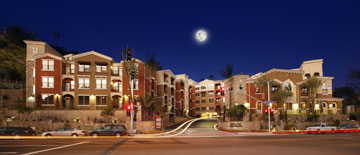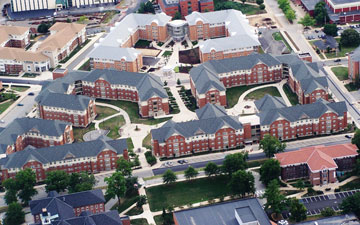Student Housing a Green Growth Area

With virtually every area of the school construction market becoming increasingly environmentally aware, one of the industry’s largest sectors — student housing — is leading the way to LEED certification.
In 2000, demand went from just two multi-unit residences on higher-education campuses working towards Leadership in Energy and Environmental Design certification soared to 34 projects in 2005, and to 88 in 2009.
“This is a remarkable statistic,” says Kristin Simmons, an associate with the Center for Green Schools at the United States Green Building Council, headquartered in Washington. D.C. “LEED-certified space has the highest penetration in higher education per foot of any sector, including government and retail. And [presently] there are at least 125 LEED-certified multi-residences on campus across the country and over 260 striving for LEED certification.”
The USGBC developed the third-party certification program in 2000, which is considered the nationally accepted benchmark for the design, construction and operation of high-performance green buildings and neighborhood.
Mike Tarle, director of design build services for the Massaro Corp., a Pittsburg, Pa., construction and real estate company, says of the dozen student housing projects his firm has completed, about half are seeking LEED certification, though mostly silver.
“Every college campus we know of is building student housing,” Tarle says. “There is definitely an arms race on college campuses to see how they can provide great facilities for their students.”
The dollar figures for this sector have also been impressive. With the exception of the last two years, higher education housing transactions has been about a $2-billion market annually.
“We anticipate the fundamentals [of this sector] to remain strong in the next three to five years, but do anticipate an increase in construction levels once the capital markets return to normal,” says Ryan Reid, national director of student housing for CB Richard Ellis, a commercial real estate services firm. “We are seeing the most construction in the Sunbelt markets,” the region stretches coast to coast across the south and southwest regions of the country.
“These markets generally have strong demographics correlating to enrollment growth and generally fewer barriers to entry for new development,” he says, adding that the Sunbelt is not unique and that there has also been increased activity in LEED-certified dorms in other parts of the country.
“Everywhere, from a small liberal arts college like Davidson College in North Carolina to large research universities, like Arizona State University, green buildings and dorms are on the rise. Students are demanding green campuses and universities are responding by taking the actions needed to make it better place to live, learn and play.

Housing Trends
Student demands in just the past five years have changed drastically as well. For example, students now live in suites with keyless entry, Wi-Fi, and in units with sustainable HVAC systems in sustainable buildings. Additionally, the demand for resort-style fitness centers tops the list in desired amenities, followed by an abundance of common area space for social activities.
Tarle says that all projects Massaro builds on campuses contain suites where each student has their own bedroom and no more than two people share bathrooms. “This is quite a change from dormitory-style housing of years prior.”
He also says that his firm just completed construction in August of Phase 4 of the Renaissance Revival main campus housing project at Indiana University of Pennsylvania in Indiana, Pa.
Working with WTW Architects of Pittsburg, this unique housing project — the largest student housing replacement project in the U.S. — was developed through a unique private/public partnership that provides students with an enhanced sustainable living/learning environment. Every bed was torn down and rebuilt from scratch over four phases. The project offers students a variety of housing options, common programming spaces, and exterior landscaped spaces. At a cost of approximately $170 million (for all four phases), there are 3,538 beds and eight buildings spanning about 1.25 million square feet.
Two other projects that Massaro recently completed includes Phase II student housing, (which is pending LEED Gold certification), and the North Quad student housing project (which has achieved LEED Silver certification), both at Allegheny College in Meadville, Pa.
The $14.5 million Phase 2 project is the final phase of on-campus housing and was completed in June 2010. Spanning 76,000 square feet, it contains 230 beds in a combination of two- and four-bedroom suites. With an Eco-star rated shingle roofing with attic spaces utilized for mechanical equipment, the structure utilizes geo-thermal wells and individual heat pumps for HVAC occupancy loads. Central laundries and trash/recyclable collection is on every floor of the four-story precast plank structure. There is also a common multipurpose room with full-service kitchen and additional laundry equipment. Site utilization is being developed to complement Phase 1 and provide pedestrian-friendly corridors and amenity space with rain gardens, walks and a courtyard for public gatherings.
The $9.6 million North Quad student housing project, which was actually completed in 2006, is comprised of nine buildings, 55 apartments and 279 beds. With its green building design, the heating and cooling system is served by a geothermal ground source glycol/water system comprised of vertical wells and associated piping.
At Spelman College in Atlanta, Ga., a student housing project called “The Suites” was completed in 2008 and is the first LEED-certified residential hall on any historically black college or university, according to Simmons. Awarded Silver certification, the building, which houses 300 students, can accommodate 100 cars in its underground parking lot. The parking deck includes parking for low-emission and fuel-efficient vehicles.
Steps were taken to guarantee minimal impact on the environment to increase indoor air quality. This included converting a previous parking lot into a green space for students, which also provides a natural habitat for local flora and fauna; steel and finishes with high-recycled contents to reduce the impact on virgin materials; low or no VOC paints; GreenGuard-certified carpets; and Forest Stewardship Council-certified wood and composite woods used in interiors space and furniture systems.
Across the country in San Diego, Calif., construction was completed in August on Sterling Collwood, the first privately funded off-campus luxury student apartments in the nation to receive LEED Gold certification. CBRE represented the seller for this project, which is also San Diego’s first and only LEED-certified urban student community. The project cost is estimated to be between $85 and $95 million.
With 206 units and 606 beds, water and energy usage can be kept to a minimum. An integrated building design was incorporated to make the building nearly 20 percent greater than what California’s stringent Title 24 Energy Code requires.
“Besides solar panels, which are used to power our 53 solar units, we designed our building with windows to take advantage of San Diego’s mild climate,” says John Caltagirone of the Dinerstein Companies, the project’s builder. “We also used gas appliances and dryers, compact fluorescent lighting, and a cool roof to decrease energy usage. To decrease our residents’ carbon footprint, we have onsite recycling, preferred parking for fuel-efficient vehicles, bike storage with free bike rentals for residents, and a private shuttle bus directly to campus to reduce the number of car trips.”
Market Projections
Though transactions in this sector have been impacted during the recession, student enrollment continues to climb on many campuses, calling for a continued need in higher education student housing.
But what happens if enrollment were to drop and housing units aren’t filled?
“We have not seen many instances of this occurring,” says CBRE’s Reid. “Even with the recent budget cuts at the state level, most universities continue to have tremendous pressure on new enrollment because of the sheer population that is reaching college age and the fact that more students are attending college today than any other period in history.”
Tarle counters this by saying that the echo boom generation of students is reaching its peak, so college enrollment will decline soon. “I think the end of the student housing boom will be in the next five years.”
Simmons says that projections at this time are difficult. She cites a McGraw-Hill 2007 market report that estimated the green building market would grow from $10 billion in 2005 to $60 million in 2010, with higher education representing 27 percent of that number.
“While the economic downturn has undoubtedly affected project registrations, you can see from the earlier numbers that there has been continual growth in higher education, from LEED-certified dorms to libraries to student centers,” she says.
What is clear, she adds, is that with 673 out of some 4,300 higher education institutions having signed the American College and University Presidents’ Climate Commitment, carbon neutral campuses are becoming a reality.
“With buildings contributing 40 percent of all CO2 emissions in the U.S., green buildings offer a key opportunity to save up to 50 percent on energy consumption if addressed properly,” Simmons says. “We like to say that green buildings make dollars and sense!
